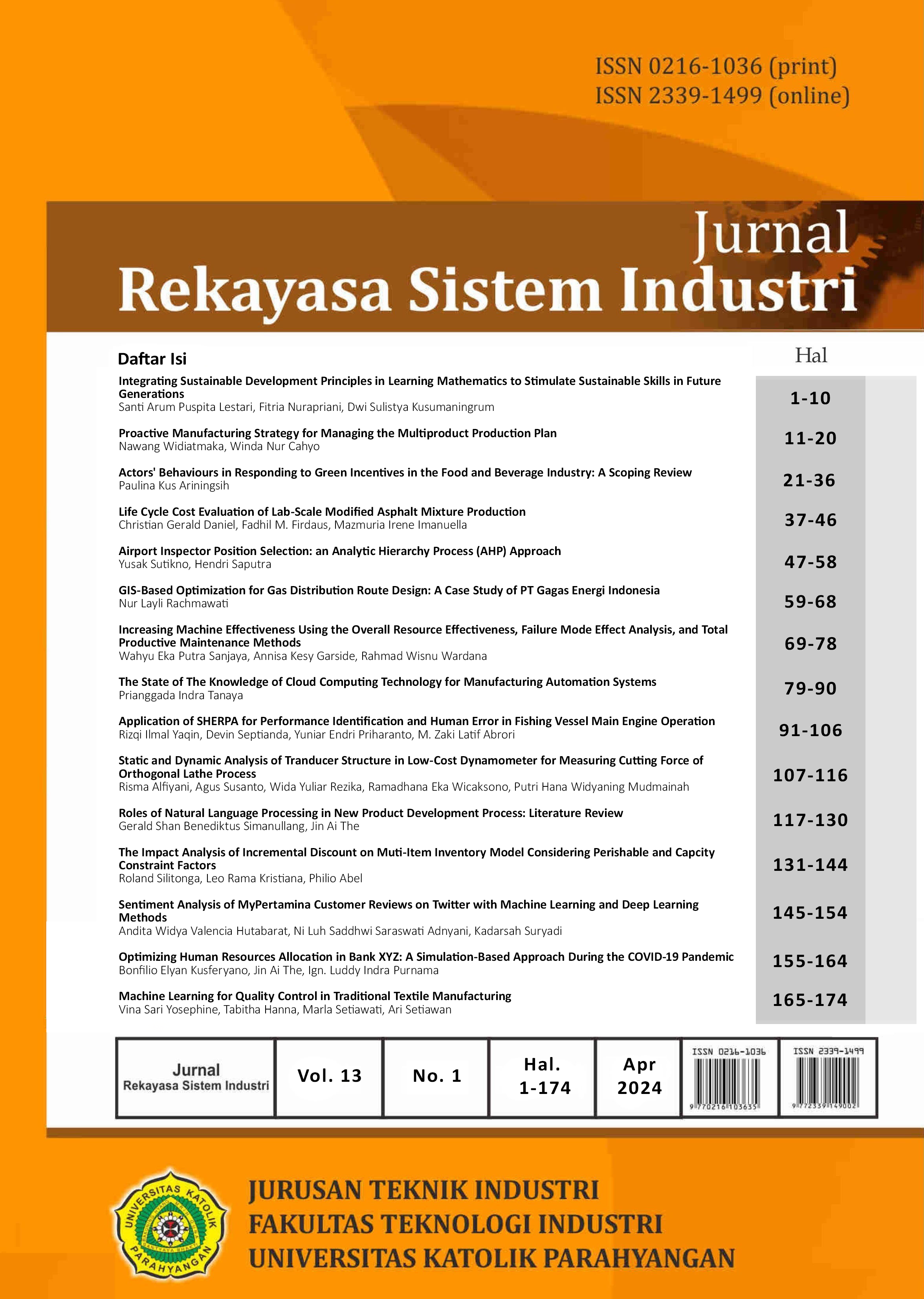Optimizing Human Resources Allocation in Bank XYZ: A Simulation-Based Approach During the COVID-19 Pandemic
DOI:
https://doi.org/10.26593/jrsi.v13i1.7183.155-164Keywords:
Arena, Human Resource Planning, Simulation, WFH, WFOAbstract
In 2020 Covid-19 Pandemic strikes the whole country. It forces Organization to change their work habits from Work from Office (WFO) to Work from Home (WFH). It is also triggered by Indonesia Government policy to keep Social Distancing and start Work from Home (WFH). Bank XYZ response by change their working policy to allow employee Work from Office and Work from Home (Hybrid). Then each employee has a different work schedule every week based on their position and Line Manager discretion. Change of amount employee who work from office affects its performance obviously, especially operational function in this case HR Data Management Function. Bank XYZ has not make a further assessment, planning or working simulation about the optimal number of WFO employees yet. By direct observation, processing time data measurement, and memo arrival time data measurement, we make a model simulation based on Arena Software to find most suggested number of WFO employee. The simulation result shows that 7 employees is the best employee number consisting of 1 Team Lead, 1 Analyst, 1 Analyst Assistant, 2 Administrator and 2 Archive Personnel. This number is less than existing employee number before, 14 employees.
References
Arsi, R. M., & Pratiwi, S. G. (2012). Analisis Beban Kerja untuk Mementukan Jumlah Optimal Karyawan dan Pemetaan Kompetensi Karyawan Berdasar pada Job Description (Studi Kasus: Jurusan Teknik Industri, ITS, Surabaya). Jurnal Teknik ITS, 1(1), 526–528. https://doi.org/http://dx.doi.org/10.12962/j23373539.v1i1.1824
Awada, M., Lucas, G., Becerik-Gerber, B., & Roll, S. (2021). Working from Home During the COVID-19 Pandemic: Impact on Office Worker Productivity and Work Experience. Work, 69(4), 1171–1189. https://doi.org/10.3233/WOR-210301
Babashov, V., Aivas, I., Begen, M. A., Cao, J. Q., Rodrigues, G., D’Souza, D., Lock, M., & Zaric, G. S. (2017). Reducing Patient Waiting Times for Radiation Therapy and Improving the Treatment Planning Process: A Discrete-Event Simulation Model (Radiation Treatment Planning). Clinical Oncology, 29(6), 385–391. https://doi.org/10.1016/j.clon.2017.01.039
Biruk, S., Jaśkowski, P., & Maciaszczyk, M. (2022). Conceptual Framework of a Fimulation-Based Manpower Planning Method for Construction Enterprises. Sustainability, 14(9), 1–13. https://doi.org/10.3390/su14095341
Choudhari, S., & Gajjar, H. (2016). Simulation Modeling for Manpower Planning in Electrical Maintenance Service Facility. Business Process Management Journal.
Damayanti, M. K. (2023). Perencanaan Kebutuhan Pegawai Berdasarkan Analisis Beban Kerja Melalui Metode FTE (Full Time Equivalent) pada PT. X. Civil Service Journal, 17(1), 1–14. https://doi.org/10.61133/pns.v17i1.388
Hanggara, F. D., & Putra, R. D. E. (2020). Analisis Sistem Antrian Pelanggan SPBU dengan Pendekatan Simulasi Arena. Jurnal INTECH Teknik Industri Universitas Serang Raya, 6(2), 155–162. https://doi.org/10.30656/intech.v6i2.2543
Ho, P. H. K. (2013). Forecasting the Manpower Demand for Quantity Surveyors in Hong Kong. Australasian Journal of Construction Economics and Building, 13(3), 1–12. https://doi.org/10.5130/ajceb.v13i3.3278
Khadafi, M., Iqbal, M. A., Analisasistem, B. R., & Keputusan, P. (2002). Pokok-Pokok Materi Teori Pengambilan Keputusan. Ghalia Indonesia. https://lib.ui.ac.id/detail.jsp?id=24944
Laksana, W. B., Febriani, A., & Rachmawaty, D. (2021). Pemodelan dan Simulasi Sistem Antrian Pelayanan Server Terhadap Pelanggan Percetakan XYZ menggunakan Arena. Jointech, 1(2), 80–86. https://doi.org/https://doi.org/10.24176/jointtech.v1i2.6493
Law, A. M., & Kelton, W. D. (1991). Simulation Modeling and Analysis. McGraw-Hill, Inc.
Morikawa, M. (2021). Work‐from‐Home Productivity During the COVID‐19 Pandemic: Evidence from Japan. Economic Inquiry, 60, 508–527. https://doi.org/https://doi.org/10.1111/ecin.13056
Parker, B., & Caine, D. (1996). Holonic Modelling: Human Resource Planning and the Two Faces of Janus. International Journal of Manpower, 17(8), 30–45. https://doi.org/10.1108/01437729610154154
Samant, S., Mittal, V. K., & Prakash, R. (2018). Resource Optimisation for an Automobile Chassis Manufacturer Through Value Stream Mapping Enhanced with Simulation Technique and Constraint Programming. International Journal of Industrial and Systems Engineering, 28(3), 379–401. https://doi.org/10.1504/IJISE.2018.089746
Tejero, L. M. S., Seva, R. R., & Fadrilan-Camacho, V. F. F. (2021). Factors Associated with Work-Life Balance and Productivity Before and During Work from Home. Journal of Occupational and Environmental Medicine, 63(12), 1065–1072. https://doi.org/10.1097/JOM.0000000000002377
Vilutienė, T., Podvezko, V., Ambrasas, G., & Šarka, V. (2014). Forecasting the Demand for Blue-Collar Workers in the Construction Sector in 2020: The Case of Lithuania. Economic Research-Ekonomska Istrazivanja , 27(1), 442–462. https://doi.org/10.1080/1331677X.2014.966972

